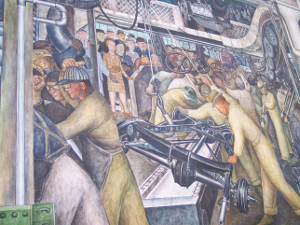 Trilliums in Ann Arbor
Trilliums in Ann Arbor
We are so relaxed here in Michigan that we allow days to pass without making any explorations. This does not mean we are not busy. After months of tweaking and cursing and learning new computer concepts we are now feeling comfortable with both of our new computers. Computers are like quadripeds. Our last Macintosh PowerBook is a Unicorn (thanks, Laura); our old Hewlett-Packard Pavilion is a Shetland Pony, our new Dell Inspiron a nervy racehorse, and our new ThinkPad a Percheron. We've broken the new ones in, though both horses and riders have seemed a little bruised, in spirit if not in body. At Bryan's insistence we have written down our lessons from the installations, but we remain skeptical that the next upgrades in a couple of years will be any easier. If only we weren't travelling we could be like Google and have thousands of cheap horses in the stable, which we would freely send to the glue farm when they didn't earn their hay.
 Trilliums in Ann Arbor
Trilliums in Ann Arbor
In fairness to the computers, we admit that we have a lot of new software, including a new multi-user genealogy program called The Master Genealogist (TMG). It's taken us quite a while to get up to speed, but this week we turned out our first reports on Chuck's family, and are pretty happy with the results. Our old products with Reunion were easy to create, but we tended to throw in a lot of extraneous material, and our source citations were sometimes embarrassingly incomplete. TMG requests the user to have professional standards, and has even more capabilities than Reunion. What's more, we can both add to the same database by networking our two PCs. We are still producing HTML output on CDs, with the aid of a companion program by John Cardinal called Second Site. Happy to provide more details to our genealogy correspondents.
But that's not what motivated us to write. We've been enjoying the cool, changeable spring weather in Michigan. Perhaps all those years in Southern California have driven us north, but now we want no part of 90 degrees, and even 80 seems warm. All shades of fresh spring green abound hereabouts, punctuated by bursts of floral color, both wild and man-made. For example, the finest stands of wild trillium are to be found on a certain golf course south of Ann Arbor. We had inside information that the golfers were all holding back for the inaugural late afternoon round followed by a big feed, so the course was almost deserted. Besides the trilliums we spotted violets and lilies of the valley and plantings of tulips. What a feast for the eyes. Thanks, Frank.
Friends and relatives have treated us to some home-cooked meals with pork roast and hard-to-find-in-restaurant veggies like chard and parsnips, and tasty bagels and lox. Thanks, Diana. Thanks, Catherine. Local restaurants have provided us with a good selection of exotic cuisine, including Korean, Lebanese, and Polish. Details on request.
Much of the collection of the Detroit Institute of Arts (DIA, but not to be confused with the Defense Intelligence Agency) is in storage or out on loan, since major building renovations lasting two years are underway. Kaye and Elsa saw some unimpressive paintings along with some statues and pots from Africa and Asia, and Arab calligraphy. DIA seems to be following the (we think poor) example of the Tate by grouping works by theme rather than period or style. It's jarring to see medieval art flanking a Mark Rothko abstract, and it's hard to believe the artists had the same thing in mind at all.
On the other hand, the travelling exhibit, American Attitude: Whistler & His Followers, is well worth visiting. Since the DIA is the proud owner of  Diego Rivera fresco
Whistler's Mother, aka Arrangement in Grey and Black, they have put together a fine specialized showing in conjunction with the High Museum of Atlanta. The show fills six galleries, beginning with portraits, landscapes, and finally Nocturne in Black and Gold: The Falling Rocket, inspired by London's Cremorne Gardens. For this mildly impressionistic work, Whistler won the opportunity of suing the art critic John Ruskin. Ruskin damned the work as follows:
Diego Rivera fresco
Whistler's Mother, aka Arrangement in Grey and Black, they have put together a fine specialized showing in conjunction with the High Museum of Atlanta. The show fills six galleries, beginning with portraits, landscapes, and finally Nocturne in Black and Gold: The Falling Rocket, inspired by London's Cremorne Gardens. For this mildly impressionistic work, Whistler won the opportunity of suing the art critic John Ruskin. Ruskin damned the work as follows:
"For Whistler's own sake, no less than for the protection of the purchaser, Sir Coutts Lindsay ought not to have admitted works into the gallery in which the ill-educated conceit of the artist so nearly approached the aspect of willful imposture. I have seen and heard, much of Cockney impudence before now, but never expected to hear a coxcomb ask two hundred guineas for flinging a pot of paint in the public's face."
The coxcomb won a farthing in damages, but sold the painting for 800 guineas. Which says something, either about wealth or about art.
In the Great Court in the center of the DIA are large frescos by Diego Rivera, created in 1932 and 1933 at which time the Ford plant at River Rouge employed 100,000 workers (today the same plant employs 6,000). The unveiling produced a wave of controversy -- the nudes were pornographic, the vaccination panel sacrilegious, Rivera was a Marxist, the walls should be whitewashed to eradicate this obscenity. The art was saved due to the efforts of the community led by the DIA and Edsel Ford, but Rivera's next efforts, Rockefeller Center, were destroyed before completion owing to the presence of a portrait of Lenin. What this may say about the art taste of Ford and Rockefeller we don't speculate. As for us, well, we like Diego Rivera's work, and are generally opposed to censorship, except for the protection of young children.